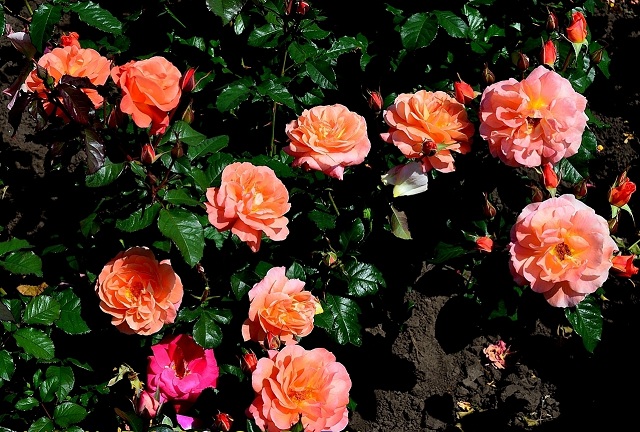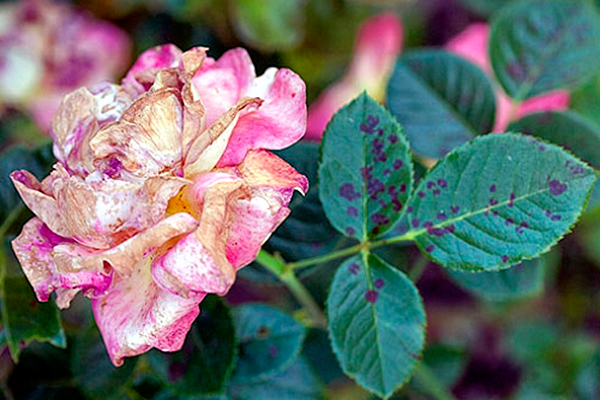Rose Aloha
Content:
It is impossible not to love the beautiful Aloha rose, covered with classic flowers, on the rounded petals of which shades of apricot pink and reddish are mixed. A climbing rose looks perfect on high supports, trellises. Its radiance can be enhanced by planting several curly companions nearby - bells, clematis, or blue flowers - sage, lavender.
From the history of the creation of the variety
Two varieties are known to breeders - an old specimen, created almost half a century ago, and a new one, bred in 2003. Comparison of plant descriptions can be made according to the table
| List of professions | Regulatory order of issue |
| Builders | signal form; gloves; PPE for face and ears; vibration reducing agents |
| Drivers | mittens; warm suit; safety shoes |
| Movers | overalls; gloves; jackets; trousers. |
| Sales staff | kerchiefs; gloves; bathrobes |
| Agricultural employees | gloves; footwear; mittens. |
| Electrical workers | dielectric special gloves; safety footwear; headdress; outerwear; thermal underwear for dielectrics. |
Beauty Aloha Cordes
Among the varieties of roses, Aloha stands out, decorated with large flowers with a huge number of petals.
A rose blooms at dawn, bending out petal by petal. The color of the inner petals is reddish, the outer ones are dark pink. It seems that the flower is shimmering. The shade of color can vary from hot rays of the sun to pale crimson, terracotta, pale pink.
They look amazing among young shiny hard bronze leaves. A rose can eject its buds twice in a summer. Aloha withstands the hot climate of the south well, but can grow in temperate latitudes with frequent rains.
Advantages and disadvantages of the variety
On the flower growers' forums, you can read admiring reviews about the beauty of the Aloha rose.
Many growers who grow the plant distinguish such qualities: a climbing bush can reach a height of 3 meters, which makes it very popular among decorators. The rose is resistant to various diseases.
The disadvantages of the variety are thorny thorns on the stems, which makes pruning and shelter difficult for the winter. Sometimes the flower is attacked by a spider mite.
The subtleties of growing varietal roses Kordes Rose Aloha
Aloha climbing rose reproduces vegetatively. To do this, in a plant that bloomed one summer, cuttings from young and healthy shoots can be cut in the spring. After the cuttings beat off the roots and get stronger, the young bush can be planted in a permanent place.
Reproduction by cuttings seems difficult to many gardeners, so they simply buy the climbing rose variety in specialized stores.
The rose can be planted in the spring, when the soil warms up, or in early autumn, so that the roots have time to grow. Most gardeners prefer fall planting because a plant planted in spring requires painstaking care.
The root system of the flower develops strongly: it requires a soil rich in minerals. In a swampy area, the rose will develop poorly. An elevated area with a good drainage system in the planting hole would be suitable for her. Sandy and clayey soils are not suitable for the bush.
The ideal side of the horizon for planting a rose bush is the northeast, an area near a fence or near a building that casts shade in the afternoon.
It is not recommended to plant a capricious beauty in an open place - she is afraid of drafts.
Step-by-step landing instructions
The planting procedure step by step can be as follows:
- Before planting, you need to cut the long roots of the bush, shorten the shoots to 15-20 cm.
- Soak the roots of the bush in a nutrient solution of phosphorobacterin for about a day.
- Immediately before planting, coat the roots with clay mixed with mullein and two heteroauxin tablets.
- The site must be prepared in advance: the soil must be dug up and a hole 60 cm deep must be dug; if it is planned to plant several bushes at once, then the distance between them should reach 1 m.
- A nutrient mixture consisting of excavated soil, peat and compost is introduced into the pit.
- The plant is placed in a hole so that the root collar is above ground level, all the roots are straightened and gradually covered with the prepared soil composition.
Plant care
Caring for a climbing rose consists of optimal watering, rational pruning and timely feeding, preventive measures for diseases, treatment with pesticides when pests appear.
About watering, the necessary moisture, feeding
The root system of a climbing rose goes 2 meters deep, so often you should not water the bush, but you need to pour 2-3 buckets of water at a time.
If the weather is dry, the rose should be watered 2 times a week. After planting, the bush can not be fed for 2 years, but in subsequent years support with organic and mineral fertilizers is needed (up to 5 times during the growing season).
About pruning and preparing for wintering
Rose pruning is done in early spring, when the buds on the shoots are still sleeping. This process is necessary to induce flowering and give the rose a decorative look.
Dried buds are removed from a newly planted young rose, but this can be done in the summer (low pruning). With medium pruning, 5-10 buds remain on the shoot, which causes early and abundant flowering. To rejuvenate the bush, all the shoots are cut almost to the root (2-3 buds remain).
The rose withstands low temperatures down to -7 ° C, but so that the shoots do not freeze, it is better to cover them for the winter. To do this, lay a layer of spruce branches, dry grass on the ground, remove the shoots from the support, tie and cover with agrofibre.
In early spring, you need to start airing, and then, as soon as the threat of frost has passed, you need to form a bush.
Why not aloha rose
Growers are often worried that a biennial rose bush refuses to bloom.
There may be several reasons:
- The main one is that when planting the bush, the wrong place was chosen and the seedling does not receive enough light.
- Climbing roses cannot be heavily pruned. If you cut the shoots heavily, you will have to wait for them to grow back and release side branches.
- Dried flowers must be cut off constantly. If this is not done, then flowering may not come.
- The gardener does not pay enough attention to the rose bush.In order for the seedling to grow and develop intensively, it is necessary not only to water and loosen the soil, but also to feed and spray in a timely manner.
- A rose from which the root shoots are not removed in a timely manner will also not bloom. Abundant root growth indicates that the planting depth was not chosen correctly.
- On the branches of a rose there may be bacterial burns that occur during the wintering of a bush under a covering material. If you do not cut out such an escape, then the burn can go to other branches.
If the rose does not bloom, then it is necessary to urgently analyze the situation and consider all the reasons regarding your rose garden.
Diseases, pests of the rose
The rose bush, even with systematic care in June, is susceptible to various diseases (powdery mildew, black spot, rust) and is attacked by pests (spider mites, leaf rollers, aphids). What to do to keep your favorite?
Measures can be as follows:
- systematic treatment with various drugs;
- regular collection and burning of leaves;
- watering under the root of the bush, but not on the leaves;
- moderate use of nitrogen fertilizers;
- mulching the soil of the trunk circle.
Gardeners in love with the Aloha rose call it a wayward beauty, but with proper care and adherence to all cultivation features, any gardener can grow the gorgeous Kordes Rose Aloha bush. The main thing is to follow the recommendations given above and not forget about disease prevention.




















